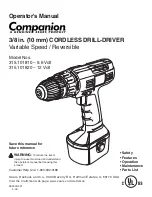
9
ENGLISH
(Original instructions)
Adjusting the screwdrive bit depth (Fig. G)
It is important to control the depth to which
the drywall screw will be driven. Over
driving the screw will drive the screw too
deep and break the outer paper layer of the
drywall. Under driving the screw will leave
the screw head above the drywall surface
making it impossible to properly fi nish the
drywall.
The depth control system is made up of the
depth stop (1) and the depth adjuster (2).
Warning!
The following adjustments should
always be verifi ed using a scrap piece of
drywall to avoid damaging the “good”
drywall sections.
1. Rotate the depth adjuster counter
clockwise until approximately 1/4” of the
screwdriver bit extends beyond the
depth stop.
2. Place a drywall screw onto the
screwdriver bit. The magnetized bit will
hold the screw onto the bit.
Note:
Before driving the screw, press the
screw point into the drywall and make
sure the screw is perpendicular to the
drywall.
3. Press the screw against the drywall with
steady even pressure and squeeze the
trigger switch. The clutch in the tool will
engage and the screw will be driven to
the preset depth.
4. If the screw is not driven deep enough,
the head of the screw will not be
recessed into the drywall (Fig. H). In this
case, turn the depth adjustment sleeve
clockwise until the correct depth has
been achieved. If the screw is driven too
deep, it will be recessed too far into the
drywall and the outer paper of the
drywall will be fractured (Fig. I). In this
case, turn the depth adjustment sleeve
counter clockwise until the correct depth
has been achieved. Fig. J illustrates the
correct depth for the screw to be driven.
Note:
For each revolution the depth
adjustment sleeve is rotated, the depth
will increase/decrease approximately
1/16” (1.6 mm).
Tips for driving drywall screws
• Always drive the screws perpendicular to
the drywall so the heads are properly
countersunk. They should never be driven
at an angle.
• Support the tool with both hands
wherever possible. This will provide better
control over the tool help eliminate
screws being driven at an angle.
• Place the drywall screw on the
screwdriver bit. The magnetic bit holder
will hold any steel screw for easy starting.
• Press the screw against the drywall with
steady even pressure and squeeze the
variable speed trigger switch. The clutch
in the tool will engage and the screw will
be driven to the preset depth. Once fully
driven, the clutch will make a chattering
sound until the variable speed trigger is
released.
• When the screw is properly driven, the
screw head will be slightly countersunk
into the drywall without breaking the
outer drywall paper. At this point, the
clutch will release to prevent over driving
the screw. This will result in minimum
work to fi ll the holes and taping the
seams.
• The belt clip allows you to conveniently
attached the screwdriver to your belt.
This will allow you to use both hands for
positioning the drywall.
Removing drywall screws (Fig. K)
To remove drywall screws, remove the depth
stop (1) to expose the screwdriver bit.
Notes:
a. The depth stop is a press fi t onto the
depth adjuster (2). Simply twist and pull
outward to slide it off the depth adjuster.
b. You can also turn the depth adjuster
clockwise to expose the screwdriver bit.
This however will cause you to lose the
depth setting and you will have to re-set
the depth.
Summary of Contents for BDSG500 Linea PRO
Page 1: ...BDSG500 www blackanddecker com EN FR PT RU TR UA AR ...
Page 2: ...ENGLISH 2 Original instructions 3 1 2 4 4 5 5 5 6 FIG A FIG B FIG C ...
Page 68: ......
Page 73: ......
Page 74: ......
Page 75: ......
Page 80: ...12 2015 ...










































